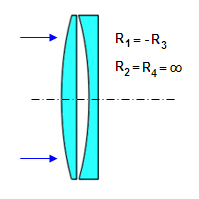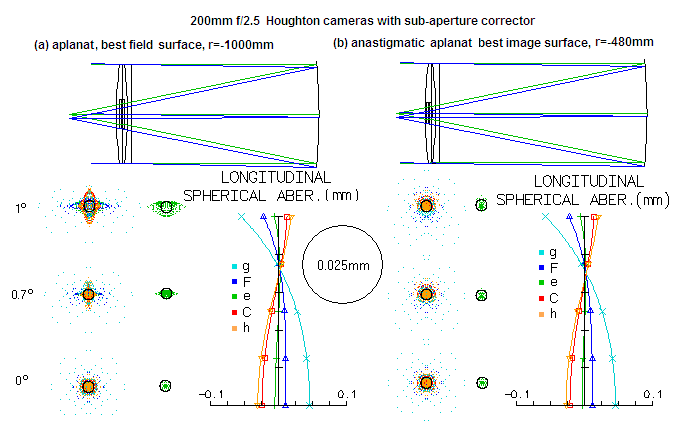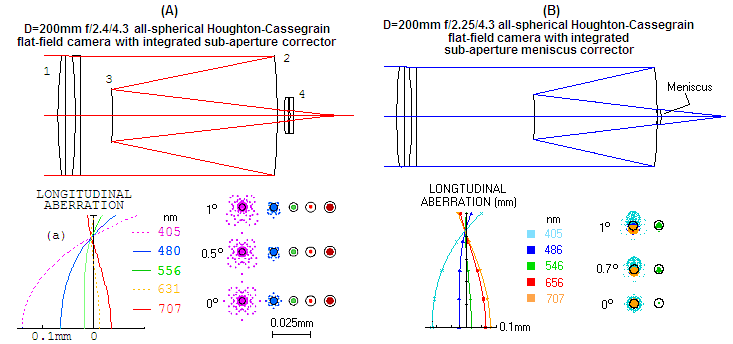|
telescopeѲptics.net
▪
▪
▪
▪
▪▪▪▪
▪
▪
▪
▪
▪
▪
▪
▪
▪ CONTENTS
◄
10.2.4.1. Houghton camera 1
▐
10.2.4.3. Houghton telescopes
►
10.2.4.2. Houghton
camera: plano-symmetrical corrector
For the fixed lens shape factor
q, correction of aberrations is
less flexible. Spherical can always be corrected, but zero coma requires
particular corrector location (assuming stop at the corrector). The most
interesting arrangement of this kind is a pair of plano-convex and
plano-concave lenses
with the lens shape factor q=1 for both
elements (which means that the curved surface in both cases faces incoming light) of equal surface curvatures of the opposite sign. In this case, the lens
element focal length (absolute value) cancelling spherical
aberration of the mirror is, from Eq. 136, given by:

with
R being, as before,
the mirror radius of curvature. Needed radius of curvature (absolute
value) for corrected spherical aberration for the two lenses is:

The
lower-order coma coefficient of the corrector is
constant, given by ccr=[(n+1)/n(n-1)]1/3/2R2,
after substituting Eq. 144 into Eq.
138 and setting q=1. For zero coma, needed corrector location is,
after setting Eq.140 to zero,
given by:

with
σ
being, as before, the mirror-to-corrector separation in units of the
mirror r.o.c. For n=1.52, the zero coma corrector separation would be 0.264R (FIG.
193).
 FIGURE
193: General prescription for plano-symmetrical
Houghton corrector made of a pair of plano-concave and plano-convex
lenses with equal curvatures of the opposite sign (plano-convex in
front, curved sides of both lenses facing incoming light), can be made
very simple for the Newtonian configuration. For given mirror radius of
curvature R, needed surface radius of curvature (absolute value) for
the two lenses is |R1,3|=
(n-1)f1,3
= (n-1)[(n+1)/n(n-1)]1/3|R|. Lens thickness should be sufficient to resist flexure,
and the two lenses are in contact or near-contact. Eq.145
gives needed separation for corrected coma. In general, it requires
relatively large secondary, in proximity of D/2. In the Newtonian
arrangement, with the corrector moved somewhat farther away from the
mirror, in order to facilitate smaller obstruction by the diagonal
flat, low residual coma remains, but it is insignificant for most
practical purposes. Chromatic correction is not as good as with
Schmidt corrector, but remains generally low with a single-glass
corrector as long as mirror relative apertures do not exceed ~ƒ/2.5.
It can be significantly reduced if corrector is made of two
different glass types. FIGURE
193: General prescription for plano-symmetrical
Houghton corrector made of a pair of plano-concave and plano-convex
lenses with equal curvatures of the opposite sign (plano-convex in
front, curved sides of both lenses facing incoming light), can be made
very simple for the Newtonian configuration. For given mirror radius of
curvature R, needed surface radius of curvature (absolute value) for
the two lenses is |R1,3|=
(n-1)f1,3
= (n-1)[(n+1)/n(n-1)]1/3|R|. Lens thickness should be sufficient to resist flexure,
and the two lenses are in contact or near-contact. Eq.145
gives needed separation for corrected coma. In general, it requires
relatively large secondary, in proximity of D/2. In the Newtonian
arrangement, with the corrector moved somewhat farther away from the
mirror, in order to facilitate smaller obstruction by the diagonal
flat, low residual coma remains, but it is insignificant for most
practical purposes. Chromatic correction is not as good as with
Schmidt corrector, but remains generally low with a single-glass
corrector as long as mirror relative apertures do not exceed ~ƒ/2.5.
It can be significantly reduced if corrector is made of two
different glass types.
Note that these expressions use the thin lens
approximation for primary aberrations, therefore they are not
necessarily sufficiently accurate. While they are
adequate for ~ƒ/4 and slower mirrors, raytracing and
optimization are recommended when the primary mirror
is of large
relative aperture (~ƒ/3, and larger).
FIG. 194 illustrates Houghton camera
performance at ƒ/3.

FIGURE 194:
ƒ/3 Houghton camera
with either plano-symmetrical (a) or symmetrical (b)
corrector type still has very good color correction, with the
limiting aberration being mirror astigmatism. Black circle
represents e-line Airy disc.
SPEC'S.
A few more words on interesting possibility of placing this type of the
Houghton corrector between
mirror and its focal plane, for cancelled spherical aberration and coma.
Depending on the glass refractive index, the aplanatic corrector location
is anywhere between ~0.7ƒ
and ~0.5ƒ
(ƒ=mirror focal length) from the mirror, for the glass index
~1.65 to ~1.5, respectively (Eq. 145). It offers good performance in an ultimately compact,
easy to build camera-type instrument,
with low astigmatism and, for most practical purposes, flat field (FIG.
195).

FIGURE 195:
A super-compact Houghton camera with
the corrector midway between the mirror and the image plane. The
cone converging from the primary is reflected by a flat - or
aluminized spot - at the rear corrector surface. With a common crown
(n~1.52) needed
minimum secondary size is nearly 0.5D; with a common flint (n~1.62),
it is nearly 0.4D. Coma is
corrected and the field is nearly flat. The only remaining
aberration is astigmatism, but it is relatively low. Field
quality and chromatism level are very similar to that of the Wright
camera, but in a half as long instrument and with all-spherical surfaces.
Main aberration in both, Houghton and Wright camera is astigmatism
originating at the primary. In the Houghton, the primary astigmatism
reduction due to the stop position is by a factor of (1-0.25)2,
and in the Wright by a factor of (1-0.5)2.
These reduction factors apply to the inherent mirror astigmatism,
which is twice larger in the Wright camera, due to the mirror conic
(K=1). In effect, Wright camera has 90% of the astigmatism of the
Houghton. Obstruction size of the Houghton can be
significantly reduced by using higher-index glass, and so can
corrector's chromatism, by using slightly different glass types for
the two elements. A BK8 substitution (for BK7) for the
rear lens of the system shown, combined with the lens spacing
increased to 14mm, results in the h-line RMS wavefront error reduced
by nearly 50%, to 0.23 wave. SPEC'S
Another option of reducing the size of
obstruction is inclusion of a simple sub-aperture corrector doublet to
correct residual coma for stop positions farther away from the primary (FIG.
196). Aberration coefficients of the sub-aperture corrector are
different than those given for the full-aperture, due to it being placed
in a converging cone of light. Consequently, the position factor p
for both lens elements of the sub-corrector has its value
changed according to
Eq. 97.

FIGURE 196: Two ƒ/2.5 Houghton-style cameras with accessible front
focal surface and sub-aperture corrector placed within the full-aperture
corrector (other configurations are possible). Off-axis correction
is noticeably better than that of the flat-field aplanat. Configuration
to the left (a) has all four lens radii of curvature identical, which
allows merely cutting out the corrector elements from the full-aperture
corrector. Design to the right (b) is corrected for both coma and
astigmatism (slight trace of coma can be eliminated by optimizing).
Field curvature in both arrangements is stronger, due to a lower, or no
astigmatism. Chromatic correction is at a similar level in all three
arrangements (black circle represents e-line Airy disc).
SPEC'S
Use of the integrated sub-aperture
corrector yields even better results in a two-mirror Houghton-Cassegrain
camera. Due to compensating effect of the secondary's field
curvature, it is possible to design a flat-field
anastigmatic aplanat, with excellent color correction (FIG. 197).

FIGURE 197:
(A) Houghton-Cassegrain
camera consisting of a full-aperture corrector (1), primary (2)
and secondary (3) mirrors, and sub-aperture corrector (4) also
consisting of a pair of plano-lenses; the system is a flat-field
anastigmatic aplanat. The last three system elements (2,3,4) require
spacing accuracy, but not out of the ordinary for this type of systems
and the primary's relative aperture. The effect of achromatizing the
full-aperture corrector (BCL22 replaced BK7) is mainly improvement in
the violet end (roughly halved the h-line wavefront error), at a price
of some error increase toward the red end (LA plots a and b
for the "plain" and achromatized version, respectively). Better
results are likely possible with more careful glass selection.
Impeccable field quality extends without significant degradation beyond
2° off-axis (black circle represents e-line Airy disc). (B)
Alternative configuration with meniscus corrector, less compact and with
stronger astigmatism, but better chromatic balance. First four radii of
curvature - two at the corrector, primary and secondary mirror - are
identical.
SPEC'S
This is not the best possible configuration,
but it is illustrative of the level of correction achievable with this
type of systems.
◄
10.2.4.1.
Houghton camera 1
▐
10.2.4.3. Houghton telescopes
►
Home
| Comments |
